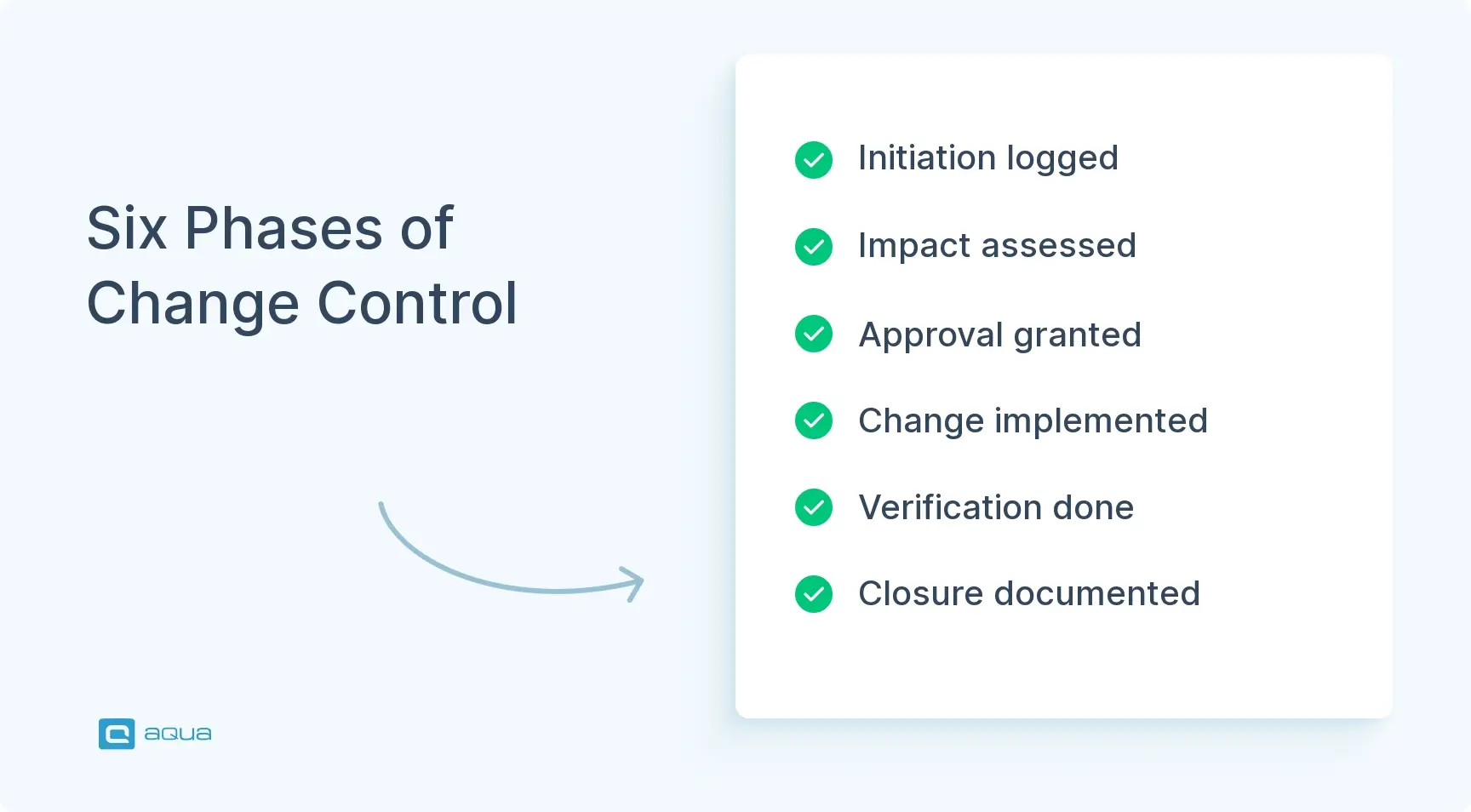Key Takeaways
- Change control creates a documented framework for evaluating, approving, implementing, and verifying modifications to requirements without compromising quality or regulatory compliance.
- The six-phase change control process includes initiation, assessment, approval, implementation, verification, and closure, creating a repeatable workflow that protects quality.
- Effective change control systems use tiered authority levels, with standard changes approved in 24-48 hours, normal changes in 5-10 days, and emergency changes in 4-24 hours.
- Risk assessment frameworks like FMEA transform subjective evaluations into structured analysis by quantifying failure modes, severity, likelihood, and detection capability.
- Documentation and traceability systems maintain relationships between different versions of requirements, design documents, and test cases to create a defensible audit trail.
Research shows 55% of month-long project disruptions stem from organizational issues, not technical failures. Discover how proper change control transforms requirements management from reactive firefighting into proactive risk governance 👇
What is change control?
Change control is how you manage modifications without breaking everything. When someone wants to change a requirement, whether it’s a tiny user story edit or a complete spec rewrite, change control gives you a clear path from idea to implementation.
In a Quality Management System, this stops unauthorized changes from sneaking into validated environments. ISO 13485 and FDA 21 CFR Part 820 require it. Every design change, document revision, and process modification needs identification, documentation, validation, review, and approval before it happens.
What makes change control work:
- Formal request process that captures what’s changing and why
- Impact assessment showing how modifications affect other systems
- Risk analysis identifying potential failures before they occur
- Approval workflows routing decisions to the right people based on change size
- Verification steps confirming changes did what they were supposed to do
- Documentation maintaining audit trails for inspections
Documentation matters here. Every change request needs a unique ID, a clear rationale, a defined scope, and stakeholder approvals. Without comprehensive records, you’re relying on people remembering things. That fails when team members leave or auditors show up. Modern QMS platforms automate most of this, but the core principle stays the same: no documentation means no proof of control, which means compliance gaps and quality risks.
Good change control speeds up the right changes while blocking messy, undisciplined modifications that create problems later.
Implementing robust change control doesn’t have to mean drowning in bureaucracy or manual documentation. aqua cloud delivers the structured framework your testing team needs with automated traceability that instantly connects every requirement to its related test cases. When changes occur, you’ll immediately see their impact across your entire testing ecosystem. No more orphaned test cases or missed coverage areas. What sets aqua apart is its comprehensive version management that maintains complete audit trails for every modification, coupled with customizable workflows that adapt to your team’s specific approval processes. Now enhanced with aqua’s domain-trained AI Copilot, you can generate requirements documentation in seconds and automatically map test coverage, all while keeping every change securely tracked and traced. Your change control becomes not just a regulatory checkbox, but an intelligent system that prevents quality risks before they cascade into costly problems.
Achieve 100% traceability and slash documentation time by 97% with aqua's AI-powered change control
The Change Control Process
Change control in a QMS follows six phases that keep system integrity intact. Each phase has a specific job in managing evolution without creating chaos.
- Initiation starts when someone spots a need for change. Your automation engineer finds a gap in regression testing. Post-market surveillance flags a safety concern. The requester documents the proposed modification, explains why it matters, and estimates the impact. This initial request gets logged with a unique identifier for tracking through the entire lifecycle.
- Assessment is where the real work starts. Technical teams check if the change is feasible. Quality specialists analyze compliance implications. Risk assessment becomes central here. You need to use tools like FMEA (Failure Mode and Effects Analysis) to identify potential failure modes, rate severity and likelihood, and figure out how well you can detect problems. A change that speeds up test execution by 20% sounds great. But if the risk analysis shows it might introduce timing-dependent flaws that visual inspection can’t catch, the number means nothing. That’s when automated validation controls get added to the implementation plan.
- Approval routes the assessed change to decision makers. Not everything needs a full Change Control Board review. Stratified authority levels help here. Your test lead approves updating a test case template (standard change). Architectural modifications affecting validated systems need CCB deliberation (normal change). High-performing organizations maintain approval timelines: 24 to 48 hours for standard changes, 5 to 10 business days for routine changes, and expedited 4- to 24-hour emergency processes when production systems fail.
- Implementation executes approved changes following documented procedures. For test automation changes, this means deploying updated scripts to your CI/CD pipeline, updating requirement traceability matrices, and notifying affected team members. The critical part is controlled execution. No undocumented workarounds. Every implementation step gets recorded, creating evidence that you followed approved plans.
- Verification confirms the change delivered intended benefits without introducing unintended consequences. QA validates that updated test scenarios actually catch the defects they’re supposed to find. Performance metrics haven’t degraded. Regulatory compliance remains intact. This phase often reveals the gap between the predicted and actual impact and provides feedback that informs continuous improvement.
- Closure wraps up the change lifecycle by documenting outcomes, updating configuration management databases, and archiving evidence for future reference and audits. Lessons learned get captured here too, informing how future similar changes get handled. This final step transforms individual changes into organizational learning.

These six phases create a repeatable rhythm that QA teams internalize over time. What initially feels bureaucratic becomes second nature, protecting quality while enabling the evolution your testing practices need.
Importance of Change Control for Requirements Management
Understanding the process is one thing. Seeing why it matters is what makes teams actually commit to doing it right. Requirements change control solves three problems that QA teams deal with constantly: uncontrolled risk, communication breakdowns, and compliance gaps.
Risk mitigation comes first
When requirements change without proper control, test cases become orphaned. They validate specifications that no longer exist or miss coverage for new functionality entirely.
Change control prevents this by forcing impact analysis before approval. Someone proposes modifying a functional requirement. The process makes them evaluate affected test cases, design documents, risk analyses, and regulatory submissions. This systematic assessment reveals hidden dependencies, like discovering that tweaking one API requirement cascades through 47 integration tests across three automation frameworks.
Communication gets fixed automatically
Without structured change control, your test automation engineer discovers requirement changes when builds start failing. The requirements analyst updated the spec last week. The information never reached the people implementing tests against those requirements.
Change control formalizes stakeholder engagement throughout the modification lifecycle. Assessment phases require input from technical teams, quality specialists, and business stakeholders before decisions happen. Implementation phases trigger notifications to everyone affected. The communication loop prevents the “wait, when did we change that?” conversations that derail sprint planning.
Regulatory compliance becomes provable
FDA inspectors and ISO auditors don’t take your word that changes were handled properly. They want evidence. Change control provides that audit trail:
- Documented requests
- Formal impact assessments
- Approval records
- Implementation evidence
- Verification results
When an auditor asks, “How do you know this test case validates the current requirement version?” you can trace the change history showing requirement evolution, corresponding test updates, and approval chains.
Here’s what this looks like in practice:
Imagine you are a part of a QA team supporting a SaaS platform transitioned to medical device classification. New change control regulatory requirements (FDA 21 CFR Part 820 and EU MDR) demanded enhanced documentation and validation. Without requirements change control, you faced chaos. Which requirements changed? Which tests need updating? What documentation would satisfy regulators?
With structured change control requirements, each regulatory-driven requirement modification flows through the full process. Assessment identifies documentation gaps. Approval confirms resource allocation. Implementation updates the tests and SOPs. Verification validates regulatory adequacy. Closure archives evidence. Six months later, during FDA pre-submission meetings, you can demonstrate complete traceability from regulatory requirements through implemented controls. That credibility accelerates the approval.
The pattern repeats across industries. Structured change control transforms requirements management from firefighting into proper risk management, and realizing the benefits of requirements management turns compliance from aspirational to provable.
Key Elements of an Effective Change Control System
Building change control that actually works takes more than writing procedures. You need governance structures, risk frameworks, and documentation processes that teams use instead of avoid.
Governance Structure and Authority Levels
The Change Control Board makes the decisions, but composition matters. Keep your CCB to 8 to 10 members maximum. Beyond that, politics overwhelm technical assessment. You need representation across domains: quality assurance, development, operations, regulatory affairs, and business stakeholders. Each member brings specific expertise and shares authority to approve changes within defined scope.
Smart organizations use tiered authority instead of routing everything through full CCB review. Your test manager approves standard changes (updating test case templates, minor documentation corrections) within 24 hours. Technical leads handle operational changes (test environment configurations, tool version updates) in 2 to 3 days. The full CCB reviews normal risk changes (new testing frameworks, process modifications affecting multiple teams) within 5 to 10 days. Executive committees tackle strategic changes (shifting from waterfall to agile testing, major tool platform migrations) when needed.
Risk Assessment Frameworks
Risk-based evaluation separates bureaucratic change control from strategic governance. When assessing proposed changes, examine multiple dimensions: scope and impact (how many systems are affected?), cost and resources (what’s the implementation burden?), complexity (how difficult is execution?), quality implications (does this affect product safety or effectiveness?), and stakeholder impact (who needs training or support?).
FMEA takes risk assessment from gut feelings to structured analysis. Your team proposes increasing automated test execution speed by 30%. FMEA forces you to identify failure modes (tests might miss timing-dependent defects), rate severity (could affect patient safety in medical contexts), assess occurrence likelihood (operators struggle with a faster pace), and evaluate detection capability (visual inspection becomes harder). The resulting Risk Priority Number quantifies risk, letting you decide objectively whether proposed benefits justify identified risks and what additional controls might reduce those risks to acceptable levels.
Documentation and Traceability Systems
Documentation is institutional memory that prevents “we thought someone handled that” failures. Every change request captures essential information:
- Unique identifier
- Requester details
- Modification description
- Business justification
- Impact assessment
- Risk analysis
- Approval chain
- Implementation evidence
- Verification results
Test management software automates much of this collection through structured forms and workflow routing.
Version control becomes critical here. When requirements change, design documents change, and test cases change. You need to track which versions correspond. Configuration Management Databases maintain these relationships, showing that Requirement v3.2 maps to Design Specification v2.4 and Test Suite v1.7. When auditors ask why a specific test exists, you trace it back through version history to the originating requirement and its evolution over time.
Centralized repositories prevent distributed chaos where change documentation lives in email threads, shared drives, and individual notebooks. Everything goes into the QMS platform, creating a single source of truth accessible to authorized personnel, secured against unauthorized modification, and backed up for disaster recovery. The audit trail tracks who accessed what, when they made changes, and why. This protects against later claims of “I never approved that.”
These elements work together to create change control that protects quality while enabling evolution. The key is the balance: enough structure to prevent chaos, enough flexibility to support necessary adaptation.
Role of Change Management in Quality Management Systems (QMS)
Change management is the bigger picture around change control. Change control handles the technical process of evaluating and approving modifications. Change management deals with how people adapt to those changes.
This distinction matters in QMS because regulatory compliance depends on both solid procedures and human execution. You can document perfect change control requirements in your quality manual, but if QA engineers don’t understand why they exist or how to use them, compliance stays theoretical.
Stakeholder engagement comes first
Everyone affected by a change needs to understand what’s happening and why. Your team transitions from manual to automated regression testing. Change control approves the new tools and frameworks. Change management addresses how testers react. Do they see automation as eliminating their jobs or freeing them up for exploratory testing? Have they received training? Do they understand how automation fits into quality objectives?
Leadership alignment keeps things moving
When executives dismiss change control as “bureaucracy slowing us down,” teams get conflicting signals. Follow procedures or move fast? Effective change management helps leadership understand that change control actually enables speed by preventing chaotic modifications that require expensive rework later. Fewer production incidents, stronger regulatory positions, reduced technical debt.
Training builds real capability
Your change control procedures mean nothing if people lack the skills to execute them properly. Train QA teams not just on filling out forms (submit change request, attach impact assessment) but on critical thinking. What questions should I ask when evaluating impact? How do I spot hidden dependencies? Develop judgment, not just procedural compliance.
Culture determines success or failure
Organizational culture decides whether change control succeeds or becomes something people avoid. In blame cultures, personnel hide changes to dodge scrutiny. In learning cultures, they surface changes early because the process helps them succeed. Change management cultivates that learning orientation, treating change control as collaborative problem solving rather than gatekeeping.
Sustained adoption needs reinforcement
Initial enthusiasm fades without ongoing attention. Regular retrospectives help teams reflect on what’s working and what needs adjustment. Metrics showing improved outcomes (fewer production incidents, faster audit closures) reinforce the value.
This integration of change management into QMS creates resilient quality systems. Procedures provide structure, but people create quality. Change management ensures they have the understanding, skills, and motivation to execute those procedures effectively.
Steps in Change Control Management
Change control management follows a systematic progression. Organizations adapt the details, but the core steps stay the same.
1. Identify the need for change
Someone spots a gap, opportunity, or problem that needs fixing. This might come from defect patterns in testing, regulatory requirement updates, customer feedback, or internal process improvements.
2. Document the change request
The requester fills out a standardized form covering what’s changing, why it matters, expected benefits, and preliminary impact assessment. This kicks off the formal change control process.
3. Conduct impact analysis
Technical teams figure out how the change affects existing systems, processes, documentation, and stakeholder groups. For testing changes, you’re identifying affected test cases, automation scripts, validation protocols, and traceability relationships.
4. Perform risk assessment
Quality specialists analyze potential failure modes, how likely they are, how severe, and whether you can detect them. High impact changes need formal FMEA. Routine modifications get simplified risk scoring.
5. Route for approval
The change request flows to the right decision makers based on predefined authority levels. Standard changes go to technical leads, normal changes to Change Control Boards, emergency changes to expedited review.
6. Make approval decision
Authorized personnel evaluate the documented request, impact analysis, and risk assessment, then approve, reject, or defer the change. Rejections include clear reasoning so the requester can revise and resubmit.
7. Plan implementation
For approved changes, detailed plans specify who does what, when, with what resources. Testing changes include updated test case mapping, automation script modifications, and validation protocol revisions.
8. Execute the change
Teams implement according to approved plans, documenting every step. This creates the audit trail showing controlled implementation rather than random modifications.
9. Verify effectiveness
Post implementation verification confirms the change delivered what you wanted without breaking something else. QA teams validate updated tests, check traceability integrity, and check quality metric impacts.
10. Close and document lessons learned
Final closure captures outcomes, updates configuration management databases, archives evidence, and documents lessons for future similar changes.
11. Monitor and review
Keep tracking whether implemented changes continue working as expected. Periodic reviews spot patterns suggesting process improvements or emerging risks.
These steps become muscle memory for experienced teams. What feels like administrative overhead at first transforms into protective governance, the difference between controlled evolution and chaotic modification.
Change Control vs. Change Management
QA professionals mix up change control and change management all the time. The terms get used interchangeably in casual conversation, but the distinction matters when you’re trying to implement both effectively.
Change management is the broader discipline addressing how people, processes, and technology adapt to change. It covers stakeholder engagement, leadership alignment, training programs, organizational culture development, and sustained adoption strategies. Change management asks: How do we help people successfully navigate transitions?
Change control focuses on the technical governance of modifications. It’s the structured process ensuring changes are properly evaluated, approved, implemented, and verified. Change control prevents unauthorized modifications to systems, documents, or processes affecting quality or compliance. Change control asks: How do we maintain system integrity while enabling necessary evolution?
The relationship is hierarchical. Change management is the umbrella. Change control is one critical component within it. Think of change management as the strategic layer (why we’re changing, how people adapt) and change control as the tactical layer (specific modification governance).
Here’s how they compare:
| Dimension | Change Management | Change Control |
|---|---|---|
| Focus | People and organizational adaptation | Technical governance and approval |
| Scope | Broad organizational transformation | Specific modifications to systems/processes |
| Primary Goal | Sustained behavior change and adoption | Controlled implementation preventing unauthorized changes |
| Key Activities | Communication, training, stakeholder engagement, culture building | Impact analysis, risk assessment, approval workflows, verification |
| Timeline | Ongoing throughout transformation (months/years) | Specific to individual change requests (days/weeks) |
| Success Metrics | Adoption rates, stakeholder satisfaction, cultural indicators | Approval cycle time, change success rate, audit compliance |
Change Management: The process of making changes to an environment, including planning, testing, documenting, and validating security is maintained as a result.
Change Control: Similar to change management, but less specific. Any system to prevent unauthorized / accidental changes.
How they work together in practice
Your QA organization decides to shift from manual to automated regression testing. That’s a significant transformation.
Change management handles the human dimensions. Communicate why automation matters (freeing testers for exploratory work rather than repetitive execution). Secure executive sponsorship (budget for tools and training). Develop tester capabilities (automation framework training programs). Cultivate cultural acceptance (automation as enabler, not job threat). This unfolds over months and requires ongoing reinforcement.
Change control governs specific technical modifications enabling that shift. Approve the test automation framework selection. Evaluate the impact on existing test case libraries. Assess risks of automated test maintenance burden. Implement new automation infrastructure. Verify that automated tests catch the defects that manual tests previously identified. Each represents a discrete change request flowing through formal approval workflows.
Both are necessary. Neither alone is sufficient. Strong change control without change management creates technically sound procedures that people resist or work around. Robust change management without change control creates enthusiastic adoption of poorly governed modifications, introducing quality risks.
Best Practices for Implementing Change Control
Organizations looking to implement or improve change control can accelerate success by following proven practices that balance governance with practical operation.
Start with clear, documented procedures
Your QA team shouldn’t be guessing who approves what or when impact analysis is necessary. Document authority levels, approval timelines, required documentation, and escalation pathways. Make these procedures accessible. Buried in a quality manual nobody reads defeats the purpose. Publish them on internal wikis or QMS platforms where they’re searchable and current.
Implement risk based stratification
Not every test case modification requires full Change Control Board review. That creates bottlenecks and decision fatigue. Define objective criteria distinguishing standard (low risk, pre approved), normal (moderate risk, requiring CCB review), and emergency (high urgency, expedited approval) changes. Your test automation engineer updating a configuration file shouldn’t wait two weeks for approval, but architectural changes affecting validated systems should.
Foster collaborative environments
When QA engineers view change control as “those people blocking my work,” they find workarounds and your governance becomes theoretical. Frame it as “How do we safely implement this change together?” Involve affected stakeholders early in assessment, making them partners in evaluation rather than presenting them with decisions already made.
Use technologies appropriately
Modern QMS platforms automate workflow routing, maintain audit trails, generate dashboards showing change metrics, and integrate with CI/CD pipelines. This reduces manual paperwork and accelerates approvals. But technology alone doesn’t create effective change control. You need clear processes and organizational commitment first, then tools that support those processes.
Conduct regular process evaluations
Track metrics like approval cycle time, change success rate, unauthorized modification incidents, and stakeholder satisfaction. If standard changes take longer than 48 hours, you have bottlenecks. If your change success rate drops (more implemented changes requiring reversal or significant modification), your impact assessment needs strengthening. Quarterly or semi annual reviews keep the process evolving.
Document and communicate decisions transparently
When change requests get rejected, a clear rationale lets requesters address concerns and resubmit. When approvals happen, communicate what was approved, the implementation timeline, and stakeholder responsibilities. Transparency builds trust. People understand that decisions are objective and consistent rather than arbitrary.
Build in continuous learning
Capture lessons learned from both successes and failures. Post implementation reviews aren’t blame exercises. They’re opportunities to identify what worked and what needs improvement. That automated test framework implementation that went smoothly? Document why future similar changes benefit. The requirement change that cascaded through 89 test cases requiring rework? Capture what warning signs were missed so that impact analysis improves.
Balance speed with thoroughness
Set and meet clear timelines. Standard changes approved within 24 to 48 hours, normal changes within 5 to 10 business days, emergency changes within 4 to 24 hours. These targets prevent change control from becoming the bottleneck everyone dreads while maintaining assessment rigor.
These practices create change control systems that teams actually use because they add genuine value. They protect quality, accelerate sound decisions, prevent expensive rework, and build regulatory confidence. The goal is a disciplined evolution enabling continuous improvement without chaos.
When searching for a solution to implement these practices, aqua cloud stands out as a purpose-built platform that addresses every aspect of the change control lifecycle. With aqua, your team gains instant end-to-end traceability across requirements, test cases, and defects/ With visual dependency mapping, aqua makes impact analysis intuitive rather than burdensome. aqua’s comprehensive version control maintains complete audit trails that satisfy even the strictest regulatory requirements, while customizable workflows ensure changes follow your organization’s approval processes. The platform’s unified repository eliminates the scattered documentation that typically plagues change management, giving your team a single source of truth. Most importantly, aqua’s domain-trained AI Copilot revolutionizes how you handle requirement changes. Organizations using aqua report up to 97% time savings on documentation while achieving complete traceability and regulatory compliance. aqua transforms change control into a strategic advantage, allowing your team to adapt quickly while maintaining quality integrity. Your QA process becomes both agile and controlled, with every change properly assessed, documented, and verified.
Transform chaotic requirement changes into controlled quality evolution with aqua's intelligent QMS
Conclusion
Requirements change constantly. The question is whether you control those changes or they control you. Structured change control prevents chaos by forcing formal assessment before implementation, making decisions based on actual risk, documenting everything for audits, and verifying that changes work as intended. Your team sees fewer production incidents, faster regulatory approvals, and stronger stakeholder confidence. Balance structure with flexibility. Prevent unauthorized modifications from breaking validated systems while supporting necessary innovation. Done right, change control turns requirements management into risk management that delivers quality outcomes and regulatory confidence.

















